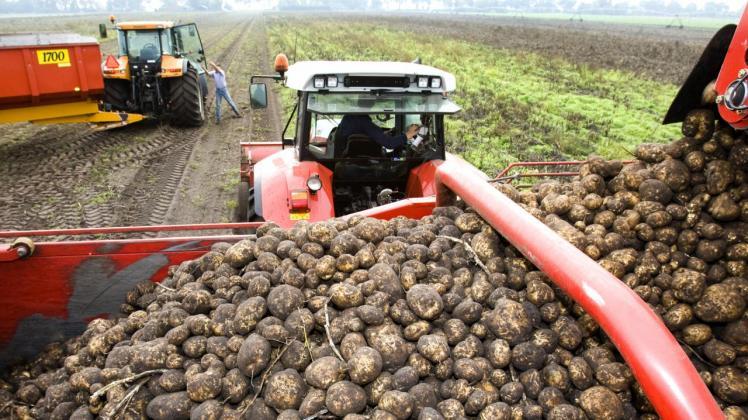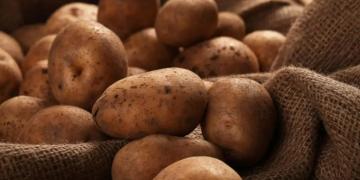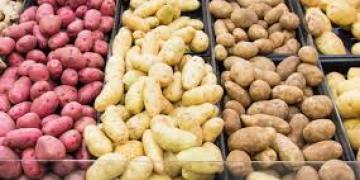Europa: The battle against viral diseases: Novel strategies for antiviral resistance in potatoes
This article was written by Jorge Luis Alonso G., an information consultant specializing in the potato crop

Scientists at the Inner Mongolia Agricultural University in China recently published a review in the journal Plants describing the advancement of antiviral strategies in potatoes through the engineering of both viral and plant-derived genes.
The article below is a summary of the information presented in this scientific paper.
1. Introduction
Potatoes, as a nutritious and staple food crop, have the potential to address food insecurity in developing countries. However, a major impediment to this aptitude is the prevalence of viral diseases in potato production, which result in the destruction of seed potatoes and often cause yield losses of 20–30%. Major viruses, including Potato virus Y (PVY), Potato leafroll virus (PLRV), and Potato virus X (PVX), cause various damaging symptoms such as leaf curling, necrosis, and stunted growth.
Complicating disease prevention, these viruses enter the plant through various vectors and use plant resources to replicate. Although virus-free seed potato technology can limit disease damage, some viruses are persistent and can re-infect during the growing season.
In addition, the hetero-tetraploid nature of the plant limits conventional breeding methods in developing antiviral potato varieties. On the positive side, advances in molecular biology and plant genetic engineering have opened the door to creating virus-resistant crops. Promising strategies have emerged, such as RNA interference (RNAi)-mediated resistance, which targets the viral coat proteins of the major potato viruses.
Eventually, genetically modified (GM) potatoes, including virus-resistant varieties, are now being introduced and commercialized in certain countries. This progress represents a major step forward in the fight against potato virus diseases.
2. Engineering Virus-Derived Viral Resistance in Potato
Researchers have developed genetically engineered virus-resistant plants, including potatoes, by using the coat protein (CP) gene of viruses such as tobacco mosaic virus (TMV), PVY, PVX, and PLRV. CP has several functions, including protection of the viral nucleic acid and regulation of the host range of infection. However, CP-mediated resistance is often limited, providing protection only against the CP donor virus or related strains and only at low viral doses. Additional complications in virus transmission can arise when the plant is transformed with the CP of an insect-borne virus.
To overcome these challenges, investigators are attempting to combine different viral CPs in the same plant or to incorporate coat protein genes with satellite RNA for a broader antiviral spectrum. An alternative approach involves replicase, an RNA polymerase encoded by viral genes. This enzyme synthesizes the positive and negative strands of viral RNA during replication. Although researchers have shown that replicase-mediated resistance is stronger than CP-mediated resistance, its specificity limits its use in the field due to the rapid mutation rate of plant RNA viruses.
In addition, antisense RNAs (asRNAs), which are complementary to messenger RNA (mRNA), have also been used for viral resistance. Although some success has been achieved in acquiring antiviral infection ability and protecting plants, antisense RNA-directed resistance is generally weak due to insufficient expression, which limits its practical application. However, there are still ways to improve the expression level of antisense RNA, which keeps this avenue open for exploration.
3. Engineering Virus-Resistant Plants Using Plant Endogenous Genes in Potato
Scientists are increasingly focusing on creating virus-resistant plants by using the plant’s own genes. They have discovered antiviral genes in both wild and cultivated potato species. These can be categorized into two distinct groups: extreme resistance (ER) genes and hypersensitive resistance (HR) genes. ER genes are known to resist many viruses and thwart viral reproduction in the early stages of infection. On the other hand, HR genes resist various virus species, triggering cell necrosis after a virus infection to limit its spread.
In potatoes, the Ry genes confer ER to all PVY strains, including the Rysto, Ryadg, and Rychc genes. Breeders have incorporated these into potato breeding programs and have identified Rysto as recognizing the central 149 amino acids of the PVY coat protein domain, suggesting its potential utility in engineering virus resistance.
The Y-1 gene is unique in its action as it induces cell death without preventing the systemic spread of PVY, thus hinting at its possible use in potato breeding. The G-Ry gene, a Y-1 homolog, has been detected to enhance resistance to PVY. Meanwhile, Ny genes, such as Ny-1 and Ny-2, have demonstrated HR against PVY in many potato cultivars. The Nytbr gene exhibits hypersensitivity to PVY, showing necrosis symptoms upon infection. Interestingly, scientists have identified the HCPro cistron of PVY as influencing necrotic reactions and resistance in plants carrying certain resistance genes.
As for resistance to PVX, it is mediated by the Rx1 gene, which causes a rapid termination of viral replication. A transcription factor that interacts with Rx1 mediates antiviral immunity, thereby enabling the Rx1 gene to confer ER to PVX.
One major and two minor quantitative trait loci (QTL) for resistance to potato leaf roll virus (PLRV), a potato disease, have been identified. The major QTL has mapped to potato chromosome XI. These identified genes associated with potato virus resistance can be used for antiviral breeding and for the development of potato varieties resistant to a single virus or many viruses. However, further research is needed to use these resistance genes and to discover new ones.
4. RNAi-Mediated Viral Resistance in Potato
RNA silencing, a common gene regulation mechanism in eukaryotes, plays a central role in protecting against viruses. This mechanism involves the interaction of small interfering RNAs (siRNAs), Dicer-like (DCL) endonucleases, and AGO family proteins. Specifically, DCL4 and DCL2 are responsible for generating siRNAs that mount a defense against RNA viruses. Further amplifying this system, RNA-dependent RNA polymerases (RDRs) convert aberrant single-stranded RNA into double-stranded RNA precursors of secondary siRNAs. This strategy is particularly promising for the development of virus-resistant transgenic plants.
In the specific context of viroid infection in plants, RNA silencing plays an important role. For example, replication of potato spindle tuber viroid in tomato plants induces resistance to RNA silencing, suggesting the critical role of secondary structures in resistance to RNAi.
The process of RNAi silencing can be manipulated to change miRNA sequences, creating artificial miRNAs (amiRNAs) that can target specific sequences. This ingenious approach has been used to engineer virus-resistant plants by creating resistant plants by creating amiRNAs that can actively fight viral infections.
In nature, however, viruses often encode silencing suppressors to counteract host RNAi-based defenses. To improve viral resistance, research is focused on enhancing RNAi activity by increasing the efficiency of AGO proteins and modifying siRNAs.
Despite extensive studies on RNA silencing as a strategy in plant antiviral protection, the beneficial effect of RNA silencing in viral infection remains somewhat puzzling. In particular, the mechanism by which some components of RNA silencing systems contribute to viral infection is not well understood. A deeper understanding of this could open up new opportunities for engineering viral resistance in various crops, such as potato.
5. CRISPR/Cas9-Mediated Viral Resistance in Potato
CRISPR/Cas, a system created to provide immune protection against invading nucleic acids in bacteria, has been repurposed for efficient genome engineering and the development of antiviral immunity in plants. This was amply demonstrated by the ability of CRISPR/Cas systems to effectively control Beet Severe Curly Top Virus (BSCTV) in N. benthamiana and A. thaliana. In addition, the CRISPR/Cas9 system has been ingeniously used to mutate susceptibility genes in rice and tobacco to confer resistance to Rice Tungro Spherical Virus (RTSV) and Potato Virus Y (PVY), respectively.
Besides these applications, the CRISPR/LshCas13a system was used in potato crops to generate resistance to Potato Virus Y, further demonstrating the potential of CRISPR technology in crop protection. Taken together, these studies underscore the significant capacity of CRISPR/Cas9 to control plant RNA viruses in major crops such as potato.
6. Future Prospects and Conclusions
As the battle against genetically complex virus strains in potato varieties escalates, researchers are moving to strengthen virus resistance. They are gearing up for a multi-pronged strategy.
First and foremost, they aim to disrupt the virus-host interaction by editing the potato genome. Using the available potato genome sequences, their goal is to construct an effective shield to protect potato plants from viral invasion. In this regard, they’ve identified CRISPR editing technology as a possible powerhouse in the fight against plant virus infections, a tool that could outperform RNAi.
Second, they are embarking on a mission to discover resistance genes that are key to antiviral response. This discovery could provide a significant boost to potato breeding efforts. Once identified, these genes will be introduced into potato plants through genetic transformation.
Third, they are formulating plans to harness the power of inducible responses in naturally virus-resistant plants. Because these plant defenses have broad-spectrum capabilities, their goal is to identify viral components that activate plant immune mechanisms. This promising area of study could reveal resistance genes that control these protective mechanisms. This, in turn, would pave the way for the development of strategies to engineer the broad-spectrum components of natural defenses.
Fourth, armed with an increasing understanding of the molecular functions of viral proteins, they plan to manipulate these proteins to create cross-protection against further viral infection in potato plants.
Finally, they see the transgenic expression of antiviral proteins of non-plant origin, including antibodies, as a promising frontier in the search for increased resistance to specific potato viruses. This approach underscores the relentless pursuit of new strategies to strengthen potatoes against viral threats.
Source: Liu, J., Yue, J., Wang, H., Xie, L., Zhao, Y., Zhao, M., & Zhou, H. (2023). Strategies for Engineering Virus Resistance in Potato. Plants, 12(9), 1736. https://doi.org/10.3390/plants12091736
Photo: Potato leafroll virus causes stunted plants. Credit Government of Western Australia
Fuente: https://www.potatonewstoday.com/2023/05/17/the-battle-against-viral-diseases-novel-strategies-for-antiviral-resistance-in-potatoes/




